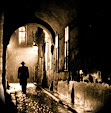
It’s no surprise that the end credits of Man On Wire list the main musical theme as the “WTC Heist Music.” After all, director James Marsh’s fantastic documentary about high-wire walker Philippe Petit is very much a heist movie, chronicling the planning, scheming, and intrigue involved in Petit’s 1974 attempt to walk a tightrope between the newly constructed World Trade Towers. Using disguises, fake names, falsified documents and months of meticulous planning, Petit and his accomplices managed to smuggle hundreds of pounds of equipment to the rooftops of the towers to engineer what the film's tagline calls “the artistic crime of the century.” It was an art heist in the grandest sense of the term, but rather than stealing a painting or a sculpture, Petit and his friends--identified in the film with espionage-inspired monikers like “the Australian” and “the Inside Man”--were stealing the opportunity to create their own absurd, sublime performance piece.
Marsh uses a number of excellently constructed reenactments to help portray the tension of the “heist,” which required the men to avoid roving security guards, at one point hiding under a sheet for hours while a guard made his rounds only feet away. Marsh never ignores the danger inherent in such a bizarre stunt, and he effectively uses the camera in his reenactments to give the viewer the feeling of being, as Philippe describes it, “on the top of the world.” (Lots of films have tried to recreate the danger of teetering on the edge of great heights, but Man On Wire is probably one of the few that will give its audience a true feeling of vertigo). Like Errol Morris, who’s made a career out of using reenactments in his docs, Marsh adds new levels of depth and artistry to the story with his cut scenes, which are often shot in grainy black and white, to the point that it's sometimes hard to tell what’s reenactment and what’s Petit’s own home movies, which are also used to great effect. There is no video of Petit’s stunning final walk between the towers, but Marsh’s deftness and the film’s pitch-perfect editing are such that you’re not likely to notice.

The story’s frenetic pace and the gripping subject matter are only enhanced by the interviews with Petit, an ebullient Frenchman and born raconteur whose poetic retelling of his own story is the most engrossing aspect of the film. As one of his accomplices says, “he draws you into his world” with his charm and creativity, which played a significant role in the successful completion of the heist. Consider how the men solved the problem of getting the wire from one tower to another: Petit examined a number of possibilities, from hitting a baseball tied to a rope to using remote control airplanes, but in the end they took the simple route and used a bow and arrow to fire a rope from one tower to another. It’s the kind of idea that anyone could come up with, but only a man crazy enough to walk a tightrope 1350 feet in the air would actually try. It’s the same attitude summed up by Philippe when he describes the formulation of his dream: “It’s impossible, sure. So let’s start working.”
While Marsh’s style and Petit’s personality succeed brilliantly in making Man On Wire compelling, an even bigger accomplishment is how quickly and completely they convince the viewer of the validity--the necessity even-- of what is essentially an absurd and pointless act. We see the beauty, the sublimity, and the artfulness that was inherent not only in the wire act but in the planning process, along with the overflowing love Philippe has for his craft, and we leave with a special gratitude for having received a gift we never even knew we wanted.


1 comment:
Just watched it. One word: AMAZING.
Post a Comment